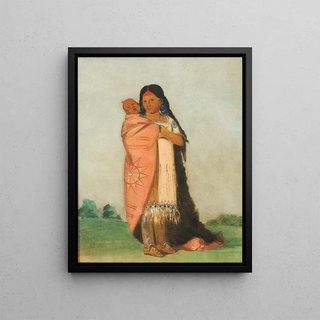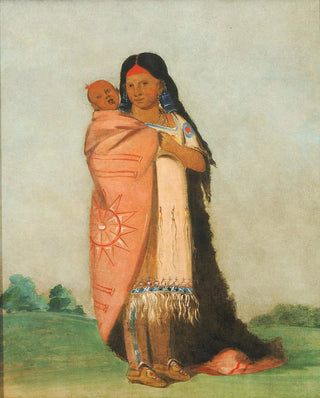Art print | TseeMont Large Wonder holding her baby in her dress - George Catlin


View from behind

Frame (optional)
In the fascinating world of American art, the artwork "TseeMont Grande Merveille portant son bébé dans sa robe" by George Catlin stands out for its emotional depth and rich cultural heritage. This painting, a true ode to motherhood and the beauty of Native American traditions, invites viewers to immerse themselves in a world where harmony between man and nature is celebrated. Catlin, as a pioneer in the depiction of indigenous peoples, captured authentic moments of life, offering a valuable testimony of a bygone era. This piece, both touching and evocative, reminds us of the importance of collective memory and ancestral stories.
Style and uniqueness of the work
George Catlin's style is characterized by a realistic approach and meticulous attention to detail. In "TseeMont Grande Merveille portant son bébé dans sa robe," he depicts traditional clothing and ornaments that symbolize the cultural identity of his subject with striking precision. The vibrant colors and rich textures of the canvas help create a lively atmosphere, where each element tells a story. The mother's posture, both protective and proud, evokes deep tenderness, while the child's gaze, innocent and curious, directly engages us. This artwork transcends a simple portrait to become a celebration of motherhood and family bonds, while paying tribute to the beauty of Native American traditions.
The artist and his influence
George Catlin, born in 1796, is often regarded as one of the first artists to document the life of North American indigenous peoples. His passion for Native American culture led him to travel across the continent, painting portraits, scenes of daily life, and ceremonial events. His work is not limited to aesthetics; it also carries a social and political mission. Catlin sought to raise awareness among the American public about the richness of indigenous cultures, often little known and misunderstood. Through his works, he opened a window onto a disappearing world, advocating for the preservation of these cultures.

Matte finish

View from behind

Frame (optional)
In the fascinating world of American art, the artwork "TseeMont Grande Merveille portant son bébé dans sa robe" by George Catlin stands out for its emotional depth and rich cultural heritage. This painting, a true ode to motherhood and the beauty of Native American traditions, invites viewers to immerse themselves in a world where harmony between man and nature is celebrated. Catlin, as a pioneer in the depiction of indigenous peoples, captured authentic moments of life, offering a valuable testimony of a bygone era. This piece, both touching and evocative, reminds us of the importance of collective memory and ancestral stories.
Style and uniqueness of the work
George Catlin's style is characterized by a realistic approach and meticulous attention to detail. In "TseeMont Grande Merveille portant son bébé dans sa robe," he depicts traditional clothing and ornaments that symbolize the cultural identity of his subject with striking precision. The vibrant colors and rich textures of the canvas help create a lively atmosphere, where each element tells a story. The mother's posture, both protective and proud, evokes deep tenderness, while the child's gaze, innocent and curious, directly engages us. This artwork transcends a simple portrait to become a celebration of motherhood and family bonds, while paying tribute to the beauty of Native American traditions.
The artist and his influence
George Catlin, born in 1796, is often regarded as one of the first artists to document the life of North American indigenous peoples. His passion for Native American culture led him to travel across the continent, painting portraits, scenes of daily life, and ceremonial events. His work is not limited to aesthetics; it also carries a social and political mission. Catlin sought to raise awareness among the American public about the richness of indigenous cultures, often little known and misunderstood. Through his works, he opened a window onto a disappearing world, advocating for the preservation of these cultures.






